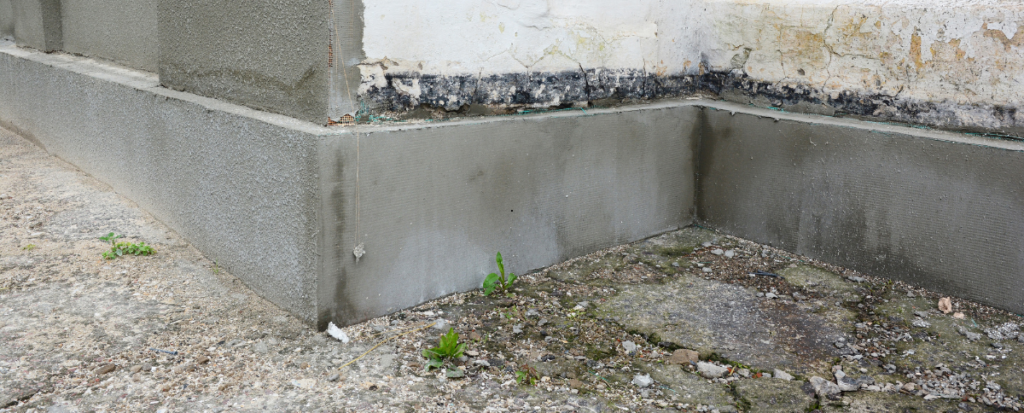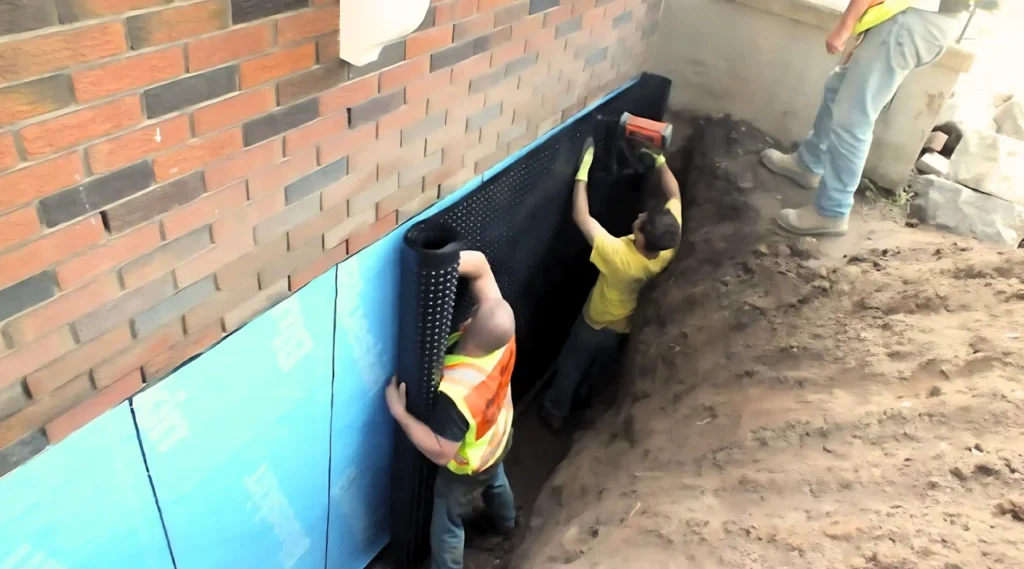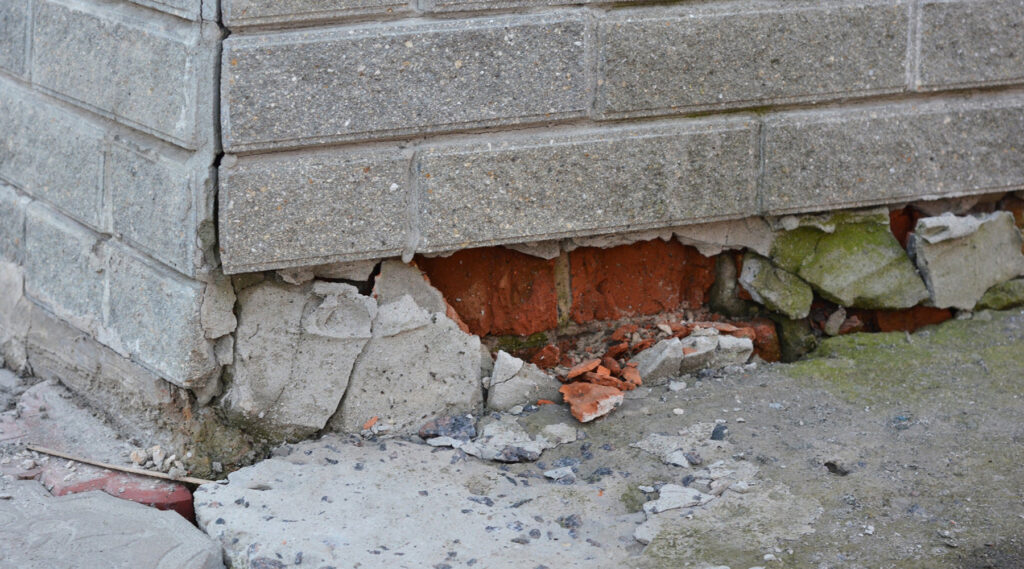Your doors are sticking, and you’ve noticed new cracks appearing in your walls. The floors feel uneven when you walk across them. Could these be signs of something serious happening to your home’s foundation?
A sinking foundation occurs when the soil beneath your home can no longer support the weight of the structure, causing the foundation to settle unevenly or drop below its original level. This creates structural problems that worsen over time if left untreated. Moreover, early detection of sinking foundation warning signs can save you thousands of dollars in repair costs.
Therefore, recognizing these warning signs helps you protect your home’s structural integrity and value. Let’s explore the key indicators that suggest your foundation may be sinking and what you should do about them.
What Is a Sinking Foundation?
A sinking foundation is a structural problem in which part or all of a home’s foundation settles below its original position due to soil failure or inadequate support. This differs from normal settling, which occurs gradually and uniformly during the first few years after construction.
Foundation sinking can affect different areas of your home at different rates, creating uneven settlement patterns. It can range from minor settling that causes cosmetic issues to major structural failure requiring extensive repairs.
Types of foundation sinking:
- Uniform settling (entire foundation drops evenly)
- Differential settling (different areas sink at different rates)
- Corner dropping (one corner of the house sinks significantly)
- Wall section sinking (portions of the foundation walls drop)
- Localized settling (small areas experiencing concentrated sinking)
Research from the American Society of Civil Engineers shows that foundation problems affect 25% of homes in the United States. Furthermore, sinking foundations are among the most serious structural issues homeowners face.
What Causes Foundations to Sink?
Soil-Related Causes
Most sinking foundation problems stem from changes in the soil beneath your home.
Common soil problems include:
- Clay soil expansion and contraction: Clay swells when wet and shrinks when dry
- Poor soil compaction: Inadequate soil preparation during construction
- Organic matter decay: Decomposing roots, stumps, or debris, creating voids
- Soil erosion: Water washing away the supporting soil from under the foundation
- Expansive soil movement: Certain soil types that move significantly with moisture
- Fill soil settling: Improperly compacted fill material continues to compress
The International Association of Certified Home Inspectors reports that soil-related issues cause 60% of foundation problems. Furthermore, these problems often worsen during extreme weather conditions.
Water-Related Issues
Water is the primary factor in most foundation sinking problems.
Water damage mechanisms include:
- Poor drainage around the foundation perimeter
- Underground plumbing leaks, washing away supporting soil
- Gutter problems are not directing roof water away properly
- Improper grading directs water toward the house
- Flooding events saturate soil and reduce load-bearing capacity
- Drought conditions are causing soil shrinkage and gaps under the foundation
Proper water management is crucial for foundation stability. Additionally, both too much and too little water can cause foundation problems.
Construction and Design Factors
Poor initial construction or design can lead to foundation sinking over time.
Construction-related causes include:
- Inadequate foundation depth below the frost line or stable soil
- Insufficient steel reinforcement in concrete foundations
- Poor concrete quality from substandard materials or mixing
- Footings too small for soil conditions and structural loads
- Missing vapor barriers, allowing moisture to affect foundation materials
- Poorly backfilled utility trenches under or near foundations
These problems may not appear immediately, but often cause issues within 5-15 years of construction. Moreover, they typically require professional structural solutions.
What are the early warning signs of a sinking foundation? How do you know if the foundation is sinking?

Exterior Warning Signs
Look for these visible signs around the outside of your home.
Foundation and structural indicators:
- Foundation cracks: Horizontal, vertical, or stair-step cracks in foundation walls
- Separation gaps: Spaces between foundation and siding, porches, or walkways
- Tilting or leaning: Walls, chimneys, or porches that appear to lean
- Uneven foundation line: Foundation that no longer appears level
- Soil gaps: Visible spaces between soil and foundation walls
- Water pooling: Standing water near the foundation that wasn’t there before
Landscape and hardscape changes:
- Sidewalk or driveway settling away from the house
- Fence or deck separation from attached structures
- Tree or utility pole leaning due to soil movement
- Plants dying or soil levels changing unexpectedly
Document exterior changes with photos and dates to track progression. Additionally, measure gaps and cracks to monitor their growth over time.
Interior Warning Signs
Interior symptoms often appear before exterior damage becomes obvious.
Structural indicators include:
- Doors sticking or not closing properly: Frame distortion from foundation movement
- Windows are difficult to open or close: Frames are becoming out of square
- Cracks in walls or ceilings: Especially near doors, windows, and corners
- Uneven or sloping floors: Noticeable dips, humps, or slopes in flooring
- Gaps between walls and ceilings: Separation indicating structural movement
- Nail pops: Nails backing out of drywall due to structural movement
Functional problems include:
- Plumbing issues like slow drains, leaks, or sewer backups from pipe stress
- Electrical problems with outlets or switches becoming loose
- HVAC difficulties from ductwork separation or system performance issues
- Cabinet doors are misaligned in kitchens or bathrooms
Interior signs often indicate that foundation problems have progressed significantly. Moreover, multiple symptoms appearing together suggest serious structural issues requiring immediate attention.
Basement and Crawl Space Signs
Foundation problems are often most visible in basements and crawl spaces.
Below-grade indicators include:
- Foundation wall cracks: Any cracks in the basement or crawl space walls
- Wall bowing or bulging: Walls that appear to curve inward or outward
- Water infiltration: New leaks or moisture problems in previously dry areas
- Floor cracks: Cracks in basement floors, especially near walls
- Musty odors: New smells indicating moisture or mold problems
- Insulation problems: Insulation falling down or becoming displaced
Structural observations include:
- Beam or joist problems like sagging, cracking, or separation
- Support posts are becoming loose or tilted
- Steps are becoming uneven or separating from the walls
- Utility lines showing stress or damage
Regular basement and crawl space inspections help catch problems early. Additionally, these areas often show the first signs of foundation movement before problems become visible upstairs.
How Do You Distinguish Between Normal Settling and Sinking Foundation?
Normal Settling Characteristics
All homes experience some settling, which is usually not cause for concern.
Normal settling features:
- Timing: Occurs primarily in the first 1-2 years after construction
- Uniformity: Affects the entire house relatively evenly
- Magnitude: Usually less than 1 inch of total movement
- Stability: Stops or slows significantly after the initial period
- Minor symptoms: Small cracks that don’t grow or change
- No functional impact: Doors, windows, and systems work normally
Acceptable settling signs include:
- Hairline cracks in walls or ceilings
- Occasional nails backing out slightly
- Tiny separations at trim joints
- Minor door adjustments are needed for proper operation
Normal settling is part of the natural process as materials adjust to loads and environmental conditions.
Problematic Sinking Indicators
Sinking foundations show different patterns that indicate serious problems.
Concerning sinking characteristics:
- Timing: Can occur years or decades after construction
- Unevenness: Affects different areas at different rates
- Progression: Continues or accelerates over time
- Magnitude: Often exceeds 1-2 inches of movement
- Growing symptoms: Cracks and problems that worsen
- Functional impact: Doors, windows, and systems affected
Serious sinking signs include:
- Cracks wider than 1/4 inch or growing over time
- Multiple problems appear together
- Issues that worsen during wet or dry periods
- Noticeable changes within months
- Beams, joists, or walls showing structural strain
When in doubt, foundation problems should be evaluated by structural professionals. Additionally, early intervention typically costs less than waiting for problems to worsen.
What Should You Do If You Suspect a Sinking Foundation?
Immediate Assessment Steps
Take these steps as soon as you suspect foundation problems.
Initial evaluation actions:
- Document everything: Take photos of all cracks, gaps, and problems
- Measure and date: Record crack widths and lengths with dates
- Monitor changes: Check weekly for progression or new problems
- Note patterns: Observe if problems worsen during certain weather
- Check utilities: Ensure water, gas, and electrical systems are safe
- Review history: Consider recent changes in drainage, landscaping, or weather
Safety considerations:
- Avoid areas that seem structurally unstable or dangerous
- Have gas leaks or electrical problems checked immediately
- Address any plumbing leaks or drainage problems promptly
- Don’t delay getting expert professional opinions
Early documentation helps professionals understand the scope and progression of problems. Moreover, it provides baseline information for monitoring treatment effectiveness.
Professional Evaluation
Have suspected foundation problems evaluated by qualified professionals.
Types of professionals to consult:
- Structural engineers: For comprehensive structural analysis and solutions
- Foundation contractors: For repair estimates and methods
- Geotechnical engineers: For soil analysis and recommendations
- Home inspectors: For general assessment and problem identification
- Foundation repair specialists: For specific repair expertise
What professionals will assess:
- Foundation condition and structural integrity
- Soil conditions, bearing capacity, and stability
- Drainage issues and water management problems
- Whether the foundation can handle the current structural loads
- Available repair options and cost estimates
Get multiple professional foundation repair opinions for significant foundation problems. Additionally, ensure all professionals are appropriately licensed and experienced with foundation issues.
Monitoring and Documentation
Establish systematic monitoring to track foundation problem progression.
Monitoring techniques:
- Crack gauges: Install devices that measure crack movement
- Photo documentation: Regular photos from the same positions
- Measurement logs: Record dimensions and changes over time
- Seasonal tracking: Note how problems change with the weather
- Utility monitoring: Watch for new plumbing or electrical issues
Documentation importance:
- Insurance claims require proper documentation for support
- Repair planning helps contractors understand the problem scope
- Legal protection documents timeline and progression
- Resale disclosure provides history for future buyers
- Treatment effectiveness measures the success of repairs
Consistent monitoring helps distinguish between stable and progressive problems. Furthermore, it provides valuable information for repair planning and insurance purposes.
When Is a Sinking Foundation an Emergency?
Emergency Situations
Certain foundation problems require immediate professional attention.
Emergency indicators:
- Rapid progression: Noticeable changes within days or weeks
- Structural instability: Walls, floors, or ceilings that seem unsafe
- Utility hazards: Gas leaks, electrical problems, or major plumbing issues
- Large cracks: Foundation cracks wider than 1/2 inch
- Severe tilting: Walls or structures leaning significantly
- Interior collapse: Ceilings, floors, or walls showing signs of failure
Immediate actions for emergencies:
- Evacuate if structural collapse seems possible
- Shut off utilities if safety is a concern
- Contact structural engineers or emergency services
- Take photos for insurance and professional evaluation
- Stay away from obviously unstable sections
Don’t take chances with structural safety. Additionally, emergency repairs often cost more than planned interventions.
Non-Emergency but Serious Situations
Some foundation problems are serious but not immediately dangerous.
Serious but stable problems:
- Changes occurring over months or years
- Doors, windows, and systems are affected but still working
- Cracks and gaps that are unsightly but not dangerous
- Problems that change with the weather but remain stable
- Issues affecting only small areas of the foundation
Appropriate responses:
- Get an expert professional assessment within weeks
- Establish systematic observation protocols
- Develop repair strategies and budgets
- Address contributing factors like drainage problems
- Schedule periodic professional reviews
Even non-emergency foundation problems require attention to prevent worsening. Moreover, early intervention typically provides better outcomes and lower costs.
How Can You Prevent Foundation Sinking?
Water Management
Proper drainage is the most important prevention strategy.
Drainage improvements:
- Grade soil away from the foundation at 6 inches per 10 feet
- Install and maintain gutters and downspouts properly
- Direct water at least 6 feet away from the foundation
- Install French drains around the foundation perimeter
- Repair plumbing leaks promptly
- Use landscaping to promote proper drainage
Soil Maintenance
Maintain consistent soil moisture levels around your foundation.
Soil care strategies:
- Water foundation area during drought conditions
- Avoid overwatering that saturates the soil
- Plant appropriate vegetation that doesn’t damage foundations
- Remove large trees too close to the foundation
- Monitor and maintain proper soil grading
Regular Inspections
Conduct regular inspections to catch problems early.
Inspection schedule:
- Monthly exterior foundation checks
- Seasonal interior inspections for new cracks or problems
- Annual professional inspections for older homes
- Post-storm damage assessment
- Immediate investigation of any new symptoms
Early detection and prevention cost far less than major foundation repairs. Moreover, consistent maintenance protects your home’s structural integrity and value.
Conclusion
Foundation problems like sinking, cracking, or uneven floors can cause severe damage if not fixed on time. That’s why it’s essential to trust experts who know how to handle every type of foundation repair. At Tri State Waterproofing, we have the tools, skills, and experience to repair sinking foundations and all other foundation issues the right way. With our reliable service and long-lasting solutions, you can feel confident that your home will stay strong and secure for years to come.
Frequently Asked Questions
How quickly do sinking foundation problems develop?
Depending on the cause, foundation sinking can develop over months to decades. Sudden changes in soil conditions can cause rapid settling, while gradual soil movement may take years to become noticeable.
Can I live in my house while foundation repairs are being done?
Most foundation repairs allow continued occupancy, though some areas may be temporarily inaccessible. Major repairs involving structural work may require temporary relocation for safety reasons.
Will foundation problems affect my home’s resale value?
Yes, foundation problems can significantly reduce home value and marketability. However, properly completed repairs with warranties can restore most of the value and buyer confidence.
How can I prevent my foundation from sinking?
Focus on proper water management, maintaining consistent soil moisture, conducting regular inspections, and addressing problems promptly. Good drainage and soil care prevent most foundation sinking issues.
Should I get a second opinion on foundation problems?
Yes, always get multiple professional opinions for significant foundation issues. Different experts may have varying perspectives on causes, solutions, and costs for your specific situation.
Are foundation problems covered by homeowner’s insurance?
Coverage depends on the cause and your policy terms. Sudden damage from covered events may be covered, but gradual settling or maintenance issues typically aren’t covered by standard policies.


